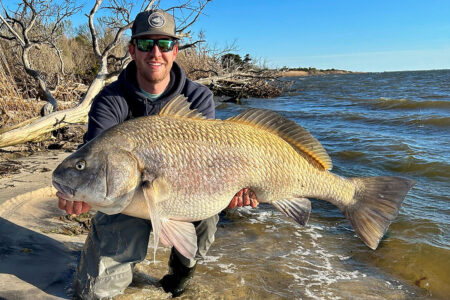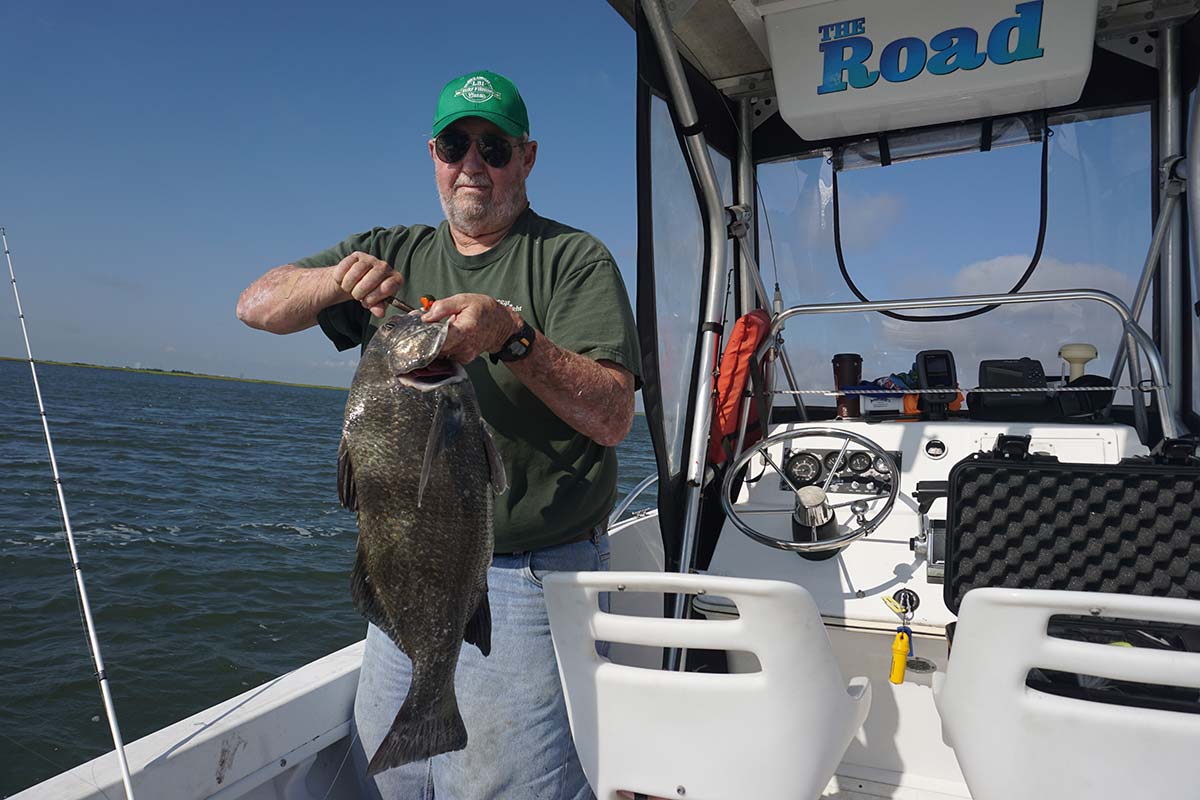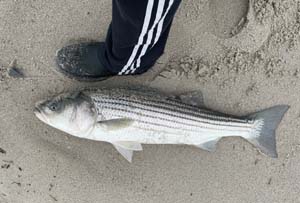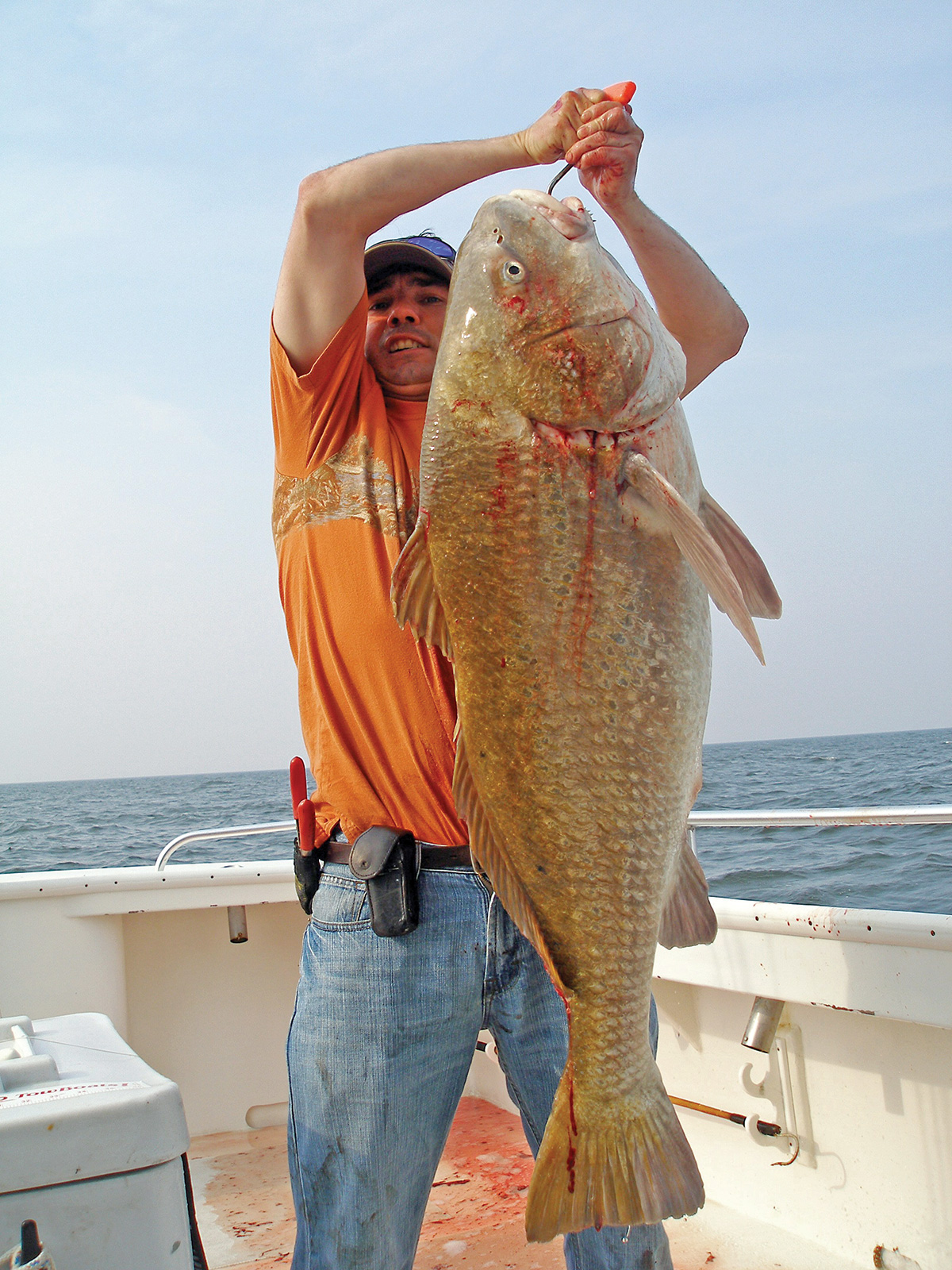
Life history, science, biology and tactics for scoring spring boomers.
Black drum are the largest members of the Sciaenidae family and can grow over 46 inches in length, weigh upwards of 120 pounds and live up to 60 years. Growing rapidly until the age of 15, soon after the growth rate slows.
Being chunky with a high rounded back and a deep notch in their dorsal fin, black drum have a dark silvery-gray body with a brassy sheen, a gray belly and black fins. Juveniles typically have four to five black vertical bars on their sides.
Members of this family of fishes, which also includes spot, weakfish and croaker, are known for their ability to produce croaking or drum-like sounds to attract mates while spawning. The sound is produced by the rhythmic contraction of sonic muscle fibers that run along both sides of the air bladder, which are connected by a central tendon. In the case of the black drum, this high intensity sound can range from 100 Hz to 500 Hz and can be heard from the shoreline and beneath the fishing boat depending on water depth.
Dogwoods Bloom
Black drum are found in nearshore waters along the Atlantic coast from the Gulf of Maine to Florida and as far south as Argentina. They migrate inshore to New Jersey waters during April, May and June to spawn and can be caught by anglers on both sides of Delaware Bay and up into Great Bay. May usually marks the peak of spawning activity, which is centered around periods of maximum current flow from full and new moons. Most of the spawning occurs at dusk or evening hours. Increased currents at these times better distribute the free floating fertilized eggs and newly hatched larvae up tidal creeks to their preferred nutrient rich, muddy water nursery habitats.
Black drum are prodigious, which means they are capable of spawning several times during their inshore migration and may spawn as frequently as every three days. Females mature at 4 to 6 years and an average sized female (13.4 pounds) may release upwards of 32 million eggs. Males mature at younger ages and smaller sizes.
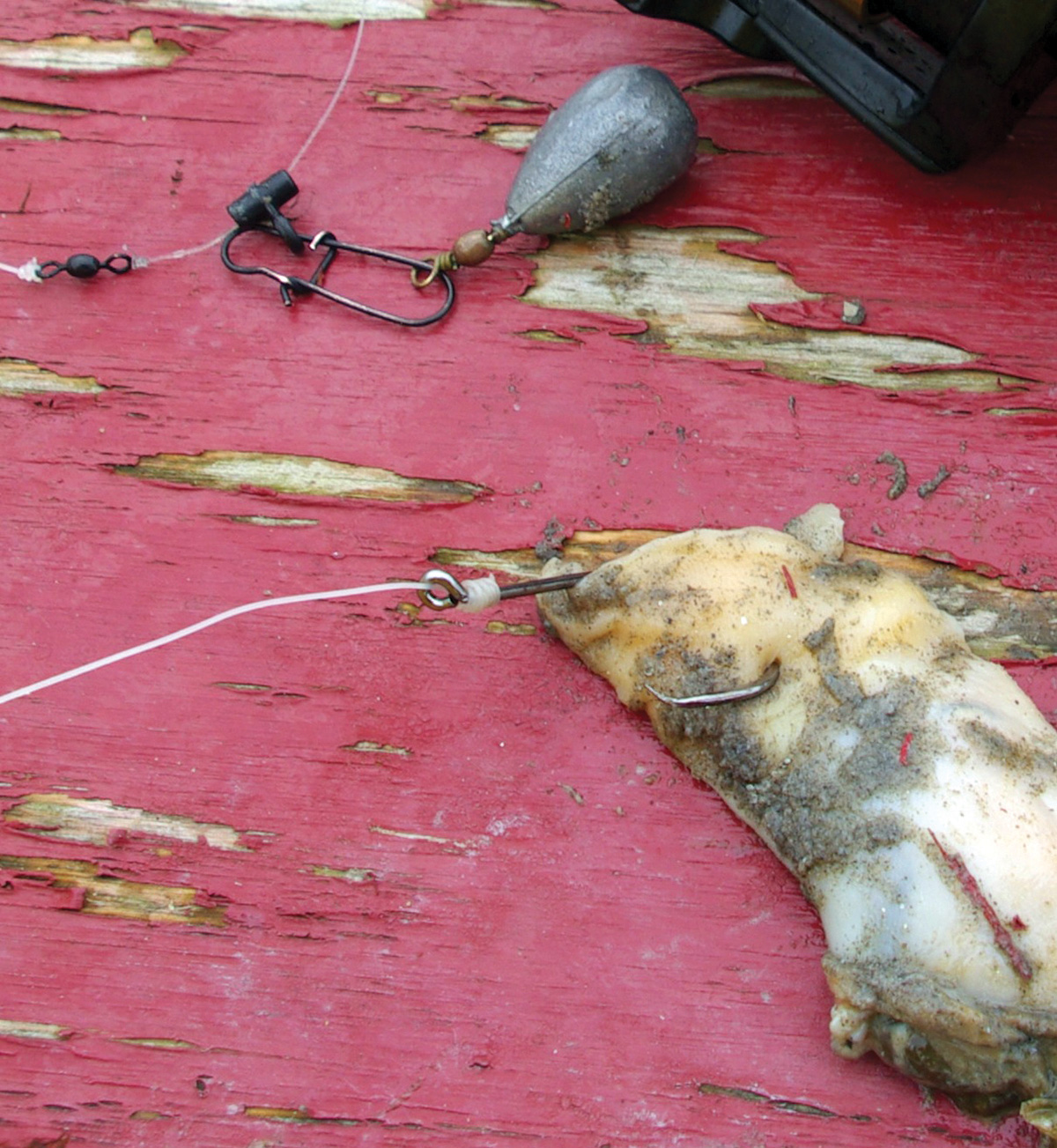
Growing rapidly in their nursey areas, by the time the young black drum are 3/4 of an inch in length they already have visible barbels that give them a “bearded” appearance. These barbels are covered by thousands of chemoreceptors used for sensing prey within the bottom substrate. Their diet consists primarily of invertebrates, such as copepods, annelids, amphipods and some small fish. However, as black drum mature their habitat and food preferences completely change. Adults become primarily bottom foragers feeding mainly on mollusks, crabs, and shrimps. Using their barbels to find food by feel and smell, they do not rely on their olfactory senses for long range sensing of food like other species such striped bass, rays and dogfish.
Black drum can dig up buried clams and crabs while feeding in a head-down position known as “tailing.” Once prey is found it is taken into the mouth and swept back to the throat to the upper and lower pharyngeal teeth, which resemble small rounded rocks and pebbles. These teeth are backed with powerful muscles and are used to clamp down and crush clams and crustaceans. Once crushed, the food is sometimes expelled to the seafloor and choice selections are consumed.
Angling for Drum
Large hooks in the 7/0 and 9/0 range set up on a fish-finder rig with a 50-pound fluorocarbon leader will not hinder a foraging black drum in any way. Black drum will interpret your hook as a piece of shell and won’t think twice about taking it into the mouth. If using surf clam for bait, an old trick for keeping the stringy portions of clam on a hook is to use unscented white dental floss. Simply wrap these pieces to the shank of the hook with the floss. Black drum can be caught equally well on both j- and circle hooks. However, a j-hook is the best choice when the bite is extremely lite and the angler needs to be totally in tune with his fishing equipment by holding it. Conversely, circle hooks are well suited when there is a highly aggressive bite or if fishing multiple fishing rods in holders at the back of the boat after anchoring up.
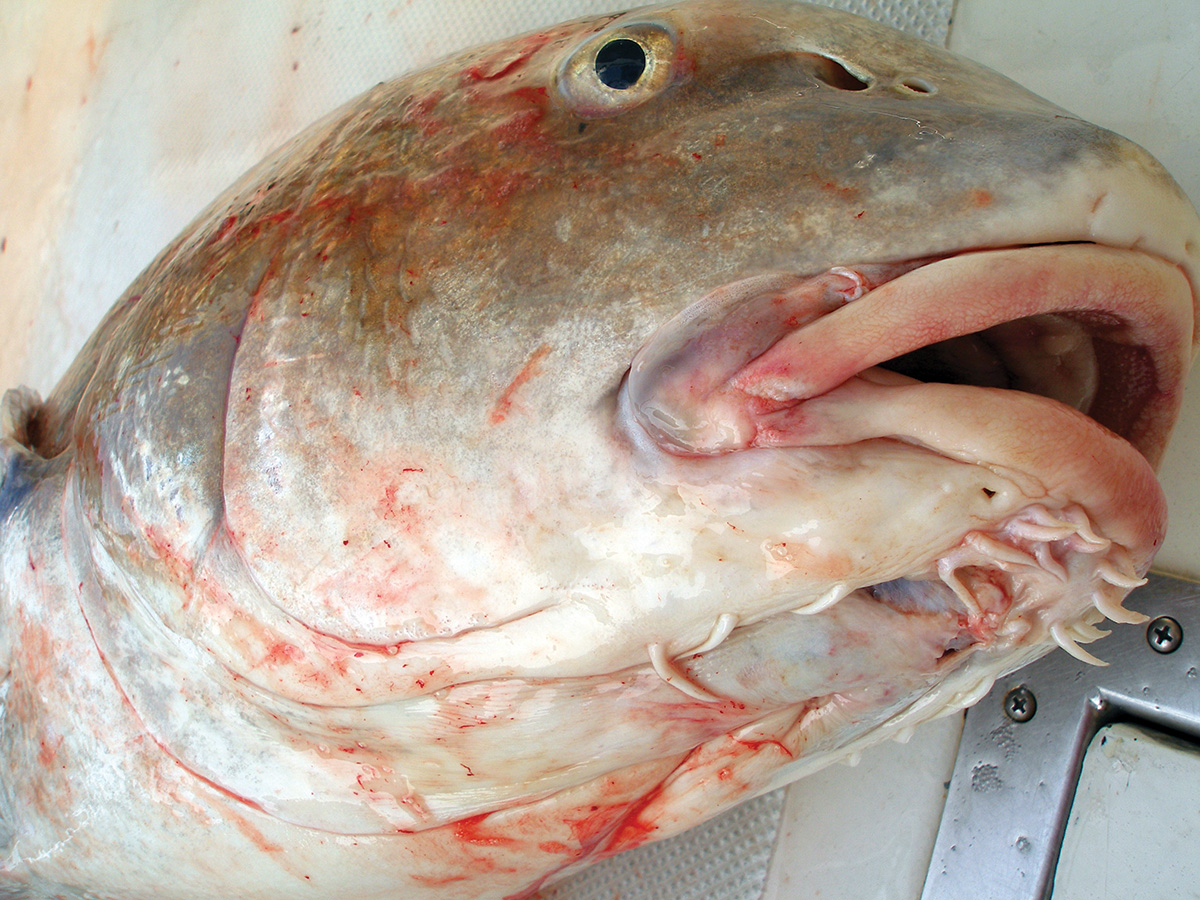
Both spinning and conventional fishing rods can be used, but conventional provides the extra leverage for controlling these massive fish. A 7-foot medium heavy rod with a fast action and strong backbone is an excellent choice. The fast action of the rod gives better sensitivity especially in high current and deeper water. Braided line in the 25- to 35-pound test range is a must to feel the notoriously light bite. A rod and reel combo like this is perfect because it will allow you to feel the light strike as well as lift these heavy fish off the bottom or out of fast current behind the boat while anchored at a hot location.
Locations for catching black drum are well known. In the Delaware Bay old favorites such as Slaughter Beach, Broad Kill Slough, Pin Top, Tussey Slough and Fishing Creek Slough are the prime fishing grounds. In Great Bay, a growing fishery is developing that has many anglers in this area excited; black drum can be caught in Great Bay around Grassy Channel, Pebble Beach and by the cedar stakes at Graveling Point that mark the leased shellfish beds.
Many factors come into play when selecting a spot to drop anchor. Black drum are dynamic, and their behavior at the time should ultimately dictate site selection. One day they may be found in large numbers over sandy areas preparing to spawn and at others they may be found in the shallows, deeper sloughs or moving to feeding zones. A fleet of boats in Delaware Bay is always a good sign, however more experienced captains stay away from the armada and circle the periphery looking for the telltale large red marks the fishfinder.
Laying Out the Spread
Once an area is identified, nose the bow into the current and quietly set the anchor. If fishing within the fleet be considerate and drop anchor at a location that is not immediately down current from another fishing boat that may be chumming to attract black drum.
Chumming can be an effective means to entice a school of black drum immediately behind the boat and increase hook ups. Used surf clam baits that have been bleached out by the current and cut into smaller pieces and then thrown over the side won’t hurt but might bring in rays and dogfish that key on scents near the sea floor. The best method, which is more in line with their feeding behavior is to simply throw a few whole cracked surf clams overboard as well as the remnant shells from shucking. These pieces go immediately to bottom and stay near the back of the boat where the black drum are rooting around for food.
The black drum’s spring trek to Delaware Bay and Great Bay is an annual event anxiously awaited by anglers. Fish in the 60- to 70-pound range are commonly caught, and their colossal size will bend fishing rods in half and provide memories for a lifetime. For those who haven’t heard it, the eerie sound of their drumming and feeling the sonic vibrations reverberating through the deck of the boat to the feet is something everyone should experience.
Many Delaware Bay anglers say that when the gnats are biting so are the black drum. Like many sayings such as this related to fishing there is some truth here, however landing an 80-pound drum is well worth the aggravation.
Black drum tastes very similar to veal and is excellent table fare. While filleting your catch consider saving the mussels in the throat around the pharyngeal teeth and use tin snips to remove a rack of abdominal ribs from the carcass. These are two delicacies often overlooked for eating and are considered by many to be the filet mignon of black drum.
Occasionally while filleting, 3-inch-long spaghetti worms (Pseudogrillotia pIeistacantha) will be found near the caudal or tail fin. One black drum may host between five and 15 worms; these worms are the larval stage of a parasitic tapeworm that infects various species of sharks and are simply using the black drum as an intermediate host to complete their life cycle.
Although spaghetti worms may be unappealing, their presence doesn’t thwart good eating. The worms are large and easy to see and can be removed with forceps, needle nose pliers or pulled free of the fillet by the fingers. Cooking of course kills the worms, and there are no human infection concerns.
The author, a licensed captain, is recently retired as fisheries biologist at the New Jersey Division of Fish and Wildlife where he managed both freshwater and marine fish species for 28 years.
| FACTS & FIGURES – REFERENCE MATERIALS |
|---|
| Interesting Fact: The scientific name of the black drum (Pogonias cromis) translates to “bearded croaker.” For more information on black drum, refer to the Atlantic States Marine Fisheries Commission. 2012, Draft Interstate Fishery Management plan for Black Drum, report to U.S. Department of Commerce, NOAA, October 2012; also, the Smithsonian Marine Station at Fort Pierce. 2016. Black Drum species profile and The Marine Scene. Southwest Florida Sea Grant Newsletter. Black Drum. |
